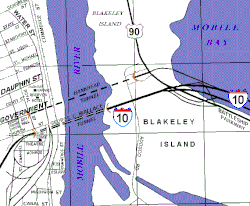
A toll road, also known as a turnpike or tollway, is a public or private road for which a fee is assessed for passage. It is a form of road pricing typically implemented to help recoup the costs of road construction and maintenance.

The Pennsylvania Turnpike, sometimes shortened to Penna Turnpike or PA Turnpike, is a controlled-access toll road that is operated by the Pennsylvania Turnpike Commission (PTC) in the Commonwealth of Pennsylvania in the United States. It runs for 360 miles (580 km) across the state, connecting Pittsburgh in Western Pennsylvania with Philadelphia in eastern Pennsylvania, and passes through four tunnels as it crosses the Appalachian Mountains in central Pennsylvania.

Bayou La Batre is a city in Mobile County, Alabama, United States. It is part of the Mobile metropolitan area. As of the 2020 census, the population was 2,204, down from 2,558 at the 2010 census.

The Lincoln Tunnel is an approximately 1.5-mile-long (2.4 km) tunnel under the Hudson River, connecting Weehawken, New Jersey, to the west with Midtown Manhattan in New York City to the east. It carries New Jersey Route 495 on the New Jersey side and unsigned New York State Route 495 on the New York side. It was designed by Ole Singstad and named after Abraham Lincoln. The tunnel consists of three vehicular tubes of varying lengths, with two traffic lanes in each tube. The center tube contains reversible lanes, while the northern and southern tubes exclusively carry westbound and eastbound traffic, respectively.

The Holland Tunnel is a vehicular tunnel under the Hudson River that connects Hudson Square and Lower Manhattan in New York City in the east to Jersey City, New Jersey in the west. The tunnel is operated by the Port Authority of New York and New Jersey and carries Interstate 78. The New Jersey side of the tunnel is the eastern terminus of New Jersey Route 139. The Holland Tunnel is one of three vehicular crossings between Manhattan and New Jersey; the two others are the Lincoln Tunnel and George Washington Bridge.

William Brockman Bankhead was an American politician who served as the 42nd speaker of the United States House of Representatives from 1936 to 1940, representing Alabama's 10th and later 7th congressional districts as a Democrat from 1917 to 1940. Bankhead was a strong liberal and a prominent supporter of President Franklin Roosevelt's New Deal of pro-labor union legislation, thus clashing with most other Southern Democrats in Congress at the time. Bankhead described himself as proud to be a politician, by which he meant that he did not neglect matters that concerned his district or reelection. He was the father of actress Tallulah Bankhead.

The JPMorgan Chase Tower, formerly Texas Commerce Tower, is a 305.4-meter (1,002-foot), 2,243,013-square-foot (208,382.7 m2), 75-story skyscraper at 600 Travis Street in Downtown Houston, Texas, United States. It is currently the tallest building in Texas and the South Central region of the United States, the tallest five-sided building in the world, the 29th-tallest building in the United States, and the 107th-tallest building in the world.

The Rotherhithe Tunnel, designated the A101, is a road tunnel under the River Thames in East London, connecting Limehouse in the London Borough of Tower Hamlets north of the river to Rotherhithe in the London Borough of Southwark south of the river. It was formally opened in 1908 by George, Prince of Wales, and Richard Robinson, Chairman of the London County Council. It is a rare example of a road tunnel where road traffic, pedestrians and cyclists all share the same tunnel bore. Transport for London took over ownership and maintenance of the tunnel in 2001.

U.S. Route 98 is an east–west United States Highway in the Southeastern United States that runs from western Mississippi to southern Florida. It was established in 1933 as a route between Pensacola and Apalachicola, Florida, and has since been extended westward into Mississippi and eastward across the Florida Peninsula. It runs along much of the Gulf Coast between Mobile, Alabama, and Crystal River, Florida, including extensive sections closely following the coast between Mobile and St. Marks, Florida. The highway's western terminus is with US 84 in Bude, Mississippi. Its eastern terminus is Palm Beach, Florida, at State Road A1A (SR A1A) near the Mar-a-Lago resort.

28 Liberty Street, formerly known as One Chase Manhattan Plaza, is a 60-story International Style skyscraper between Nassau, Liberty, William, and Pine Streets in the Financial District of Manhattan in New York City. The building, designed by Gordon Bunshaft of Skidmore, Owings & Merrill (SOM), opened in 1961. It is 813 feet (248 m) tall.

The Hampton Roads Bridge–Tunnel (HRBT) is a 3.5-mile-long (5.6 km) Hampton Roads crossing for Interstate 64 (I-64) and US Route 60 (US 60). It is a four-lane facility comprising bridges, trestles, artificial islands, and tunnels under the main shipping channels for Hampton Roads harbor in the southeastern portion of Virginia in the United States.

The Alabama State Capitol, listed on the National Register of Historic Places as the First Confederate Capitol, is the state capitol building for Alabama. Located on Capitol Hill, originally Goat Hill, in Montgomery, it was declared a National Historic Landmark on December 19, 1960. Unlike every other state capitol, the Alabama Legislature does not meet there, but at the Alabama State House. The Capitol has the governor's office and otherwise functions as a museum.
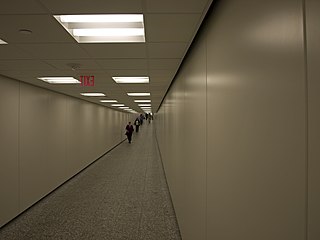
The Houston tunnel system is a network of subterranean, climate-controlled, pedestrian walkways that links 95 full city blocks 20 feet (6 m) below Houston's downtown streets. It is approximately six miles (9.7 km) long. There are similar systems in Chicago, Dallas, Oklahoma City, Montreal, and Toronto. Architectural historian Stephen Fox has stated that the idea for the tunnel system came when the Bank of the Southwest Building was "linked by tunnel to the 1010 Garage and the Mellie Esperson Building" in 1961.

The Stormwater Management And Road Tunnel, E38, is a storm drainage and road structure in Kuala Lumpur, Malaysia, and a major national project in the country. The 9.7 km (6.0 mi) tunnel is the longest stormwater drainage tunnel in Southeast Asia and second longest in Asia.
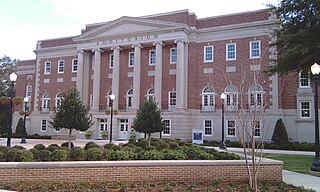
Foster Auditorium is a multi-purpose facility at the University of Alabama in Tuscaloosa, Alabama. It was built in 1939 as a Works Progress Administration project and has been used for Alabama basketball, women's sports, graduations, lectures, concerts, and other large gatherings, including registration. Its status as the largest indoor building on campus came to an end in 1968 with the opening of the Memorial Coliseum. The building housed the Department of Kinesiology until 2006. In April 2009, the University announced a major renovation for the auditorium. After the renovation, the Crimson Tide women's basketball and volleyball programs moved back to Foster Auditorium, their original home.

The George Wallace Tunnel is a pair of road tunnels that carry Interstate 10 through Mobile, Alabama from the city's downtown, going beneath the Mobile River, and emerging on Blakeley Island where they join the Jubilee Parkway over Mobile Bay.
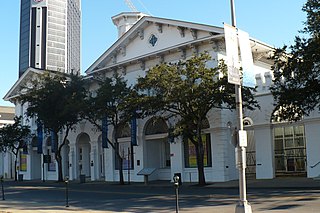
Old City Hall, also known as the Southern Market, is a historic complex of adjoining buildings in Mobile, Alabama, that currently houses the History Museum of Mobile. The complex was built from 1855 to 1857 to serve as a city hall and as a marketplace. It was declared a National Historic Landmark in 1973, as a rare well-preserved example of a 19th-century multifunction civic and commercial building.

The Conde–Charlotte House, also known as the Kirkbride House, is a historic house museum in Mobile, Alabama. The earliest section of the building, the rear kitchen wing, was built in 1822. The main section of the house was added a few decades later and is two and a half floors. The entire structure is constructed of handmade brick with a smooth stucco plaster over the exterior.
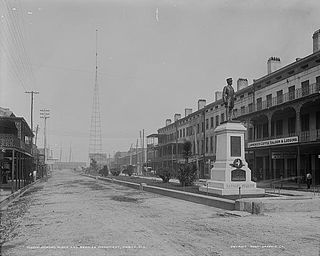
Government Street is the name given to portions of U.S. Route 90 (US 90) and US 98 within the city limits of Mobile, Alabama. It is known as Government Boulevard west of Pinehill Drive, and as Government Street east of it. It is the most important road on Mobile's far south side and is the only nominally east–west road on Mobile's south side to enter the city from outside the western city limits and reach the downtown business district. The only other two east–west thoroughfares in the city to do so are Moffett Road/Springhill Avenue and Old Shell Road. Government Street is a four-lane highway throughout the city limits, from Water Street to the western city limits. It is the only thoroughfare in Mobile to have interchanges with both Interstate 10 (I-10) and I-65 within the city limits.

There are six special routes along U.S. Route 98 and seven former routes. Most US 98 bannered routes are located in the U.S. state of Florida.

